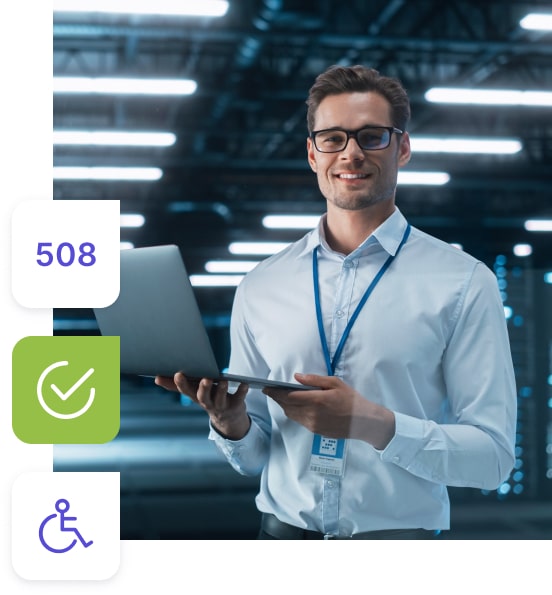Section 508 of the Rehabilitation Act is a significant piece of legislation regarding web accessibility in the United States. It ensures that all federal agencies make their information and communication technology fully accessible to people with all types of impairments, including visual, auditory, cognitive, and mobility impairments. Section 508 adheres to the Web Content Accessibility Guidelines (WCAG).
Developed by the World Wide Web Consortium, it is an internationally recognized set of guidelines and best practices for website, mobile application design, multimedia content, text alternatives, and more.
This guide explores the Section 508 compliance testing process, testing methods, and best practices for implementing it to create a more inclusive world for all people with disabilities.

What is 508 Compliance Testing?
Section 508 testing ensures that all accessibility standards under the Rehabilitation Act of 1973 are met through rigorous checks. Specifically, these checks ensure that all electronic Information Technology used by federal agencies and organizations is fully accessible to people with different impairments (visual, auditory, cognitive, or mobility), to ensure no accessibility issues across websites, mobile applications, and electronic documents.
A key aspect of section 508 testing is close conformance with the WCAG 2.0 guidelines, particularly WCAG 2.0 Level AA, which is heavily advocated for by global accessibility legislation efforts, such as the European Accessibility Act and the Equality Act 2010 (UK). Consider this the ultimate success criteria for section 508 compliance testing for any web page or mobile application.
In order to comply, businesses and organizations usually have web designers and web developers ready to work towards accessibility, with no shortage of manual testing and automated testing using automated accessibility testing tools.
Key Elements of 508 Testing
508 Accessibility testing strives to ensure that all digital content and software applications operate based on core operating principles: Perceivable, Operable, Understandable, and Robust.
Perceivable
Perceivable ensures that all website elements are optimized for individuals with disabilities. For instance, properly formatted HTML and correct accessibility requirements for headings improve readability and perform very well during conformance testing.
Features can include a combination of alternative text for images, multimedia captioning, readable text, and high contrast between text and background colors, essential for those with poor vision. Additionally, this principle emphasizes adaptability, focusing on simplifying navigational structure with an emphasis on adequately formatted HTML, ensuring consideration of headings and logical structure to minimize confusion.
Operable
To meet Section 508 testing with web applications and mobile applications, web developers must make them operable.
One of the best ways to do that is to make websites keyboard accessible, meaning all functionality on a website (even interactive elements) can be performed using a series of keyboard shortcuts rather than mouse movement. Furthermore, websites should extend time limits on reading content, reduce the number of flashing elements to minimize sensory impairments, and ensure various input modalities and alternative ways to interact, such as touch screen functionality.
Understandable
The understandable principle seeks to ensure that all individuals with disabilities fully comprehend all the information on a website or mobile application. This includes making content accessible to read, emphasizing input assistance. For example, error messaging should be explicitly clear, and all form fields should quickly return the correct output based on user input. Additional confirmation steps, such as for e-commerce purchases, may be necessary for individuals with disabilities who require more guidance.
Two popular websites that represent the understandable principle well are Amazon and Walmart.com. Another good example is federal websites like IRS.gov that include accessibility features for individuals with disabilities.
Robust
The robust principle ensures that content, electronic, information, and communications technology can be interpreted by a wide range of assistive technologies designed for this purpose. For instance, all websites and web content should be fully scannable by assistive technologies like screen readers and magnifiers.
Properly formatted HTML and ARIA (Accessible Rich Internet Applications) attributes play a vital role in assigning correct attributes to dynamic and interactive elements like carousels and sliders.
Altogether, the POUR guidelines form the core of the WCAG, ensuring individuals with disabilities can fully interact with websites for an inclusive online experience. Don’t forget about Adobe PDF documents accessibility to avoid violating WCAG guidelines.

The Benefits of 508 Testing
Section 508 testing offers numerous benefits for individuals and organizations.
Improved User Experience
Section 508 testing boosts the overall user experience, making web content and mobile applications more accessible and ensuring compatibility with assistive technologies like screen readers and switch access.
Since federal agencies must ensure that all electronic Information Technology is fully accessible, this leads to greater inclusivity. For example, the United States Department of Education’s website effectively incorporates accessibility features such as descriptive alternative text and screen reader compatibility, along with hundreds of other navigable elements that comply with Section 508.
Legal Compliance
Secondly, complying with Section 508 regulations minimizes legal risks for federal agencies and institutions. A 2015 United States Department of Justice investigation revealed that Harvard University violated several Section 508 standards by providing inaccessible online learning platforms and missing alternative text – a clear breach of accessible electronic and information technology. This led to a Department of Justice settlement in 2018, which included accessibility improvements, ongoing user testing, and annual audits with accessibility reports to ensure compliance.
Improved Reputation
Lastly, adhering to Section 508 testing enhances brand reputation by demonstrating a commitment to inclusivity and promoting equal access to websites, electronic documents, and more.
An article by Forbes highlights how accessibility can no longer be viewed as a feature but as a necessity for any organization, especially within the technology sector. Improved user experience, minimized legal risk, and enhanced brand reputation are compelling reasons for organizations to incorporate Section 508 testing into their web development strategies.
Improving User Experience for People with Disabilities
When it comes to Section 508 testing, several strategies can improve user experience for people with disabilities:
Consistent Navigation Structure
Creating a consistent navigation structure is crucial. Individuals with color blindness or other impairments must be able to easily navigate between different website elements using keyboard shortcuts instead of relying on mouse movements. It is recommended that interactive elements carry a focused state, such as highlighted borders, to help individuals with disabilities understand which element is being selected. On complex e-commerce sites like Amazon and Walmart.com, maximum accessibility means that individuals with disabilities can navigate product listings, remove items from their cart, and perform other essential website functions using only their keyboard. Incorporating skip navigation links is also beneficial to avoid repetitive menus.
Watch Your Forms and Fields
Ensuring properly formatted forms and input fields is critical for accessible websites. Assistive technologies must be able to read all labels for form fields. Relying on placeholder text is not sufficient; each label should explicitly state the purpose of the element. For instance, a last name form field should be labeled as “Last Name.” The IRS website exemplifies excellent form and input field accessibility, as it is compatible with screen readers, making navigation easy for individuals with disabilities.
Steps in the 508 Testing Process
Achieving Section 508 testing requires the following steps:
Accessibility Audit
The initial step is conducting an accessibility audit. This may involve automatic, manual, or hybrid testing strategies with tools like WAVE (Web Accessibility Evaluation Tool) or accessibility overlay widgets like Accessibly.
Focus on POUR
Next, it is essential to thoroughly understand the WCAG based on the operating principles: Perceivable, Operable, Understandable, and Robust. Each principle focuses on specific areas of web design. For example, the Operable principle ensures that all websites can be navigated using only a keyboard (a concept called keyboard navigation), which is crucial for users with limited mobility.
Put Accessibility Design into Practice
Finally, put accessibility design into practice by following through on all recommendations from the audit. For instance, all images should include descriptive alternative text to aid visually impaired users in digesting content. Furthermore, ensure that text and background colors have a high contrast ratio to enhance readability for individuals with dyslexia, color vision impairment, and partial blindness. It is important to recognize that testing is a rigorous, iterative process, as new features are continuously added over time.
For more information on accessibility design, check out the compliance checklist

Tools and Resources for Effective Testing
Section 508 of the Rehabilitation Act requires businesses and organizations to utilize compliance testing tools and software effectively. Several free tools are available, including WAVE, the Axe Accessibility Checker, and the Accessibility widget.
WAVE
Developed by WebAIM (Web Accessibility in Mind), WAVE is a popular web accessibility evaluation tool. It scans an entire website and places icons throughout to indicate areas with accessibility issues. The tool provides detailed reporting and multiple testing options, such as browser extensions for real-time testing. It is user-friendly and caters to both technical and non-technical users, simplifying the process of identifying issues and implementing recommendations.
Axe
The Axe Accessibility Checker, developed by Deque Systems, allows users to perform automated testing to verify compliance with WCAG 2.1 guidelines. Scanning any website reveals issues such as poor color contrast and improperly formatted semantic HTML. This tool offers real-time feedback, enabling users to address accessibility issues before code deployment. Like WAVE, Axe is an automated tool that provides valuable insights for improvement.
For more on 508 compliance, consider exploring online training resources to understand accessibility testing tools/software applications, including those used by federal government agencies and other regulatory bodies for 508 accessibility testing.
Accessibly
Accessibly is one of the best tools for Section 508 compliance by enhancing features for web pages , web applications, and mobile applications.
It enables website owners and developers to enhance compliance by introducing various features for individuals with disabilities. These features include alternative text for images, accessible media, consistent layout, and error identification suggestions. Accessibly allows users to overlay customizable elements on sites, such as larger text and highlighted links, to improve navigability for individuals with visual, hearing, or cognitive impairments. Accessibly offers a free seven-day trial for its core features, with monthly pricing starting at $20 for Shopify and $25 for other platforms.
In conclusion, Section 508 compliance testing is essential for creating an inclusive digital experience for all users. By understanding the principles of accessibility, conducting thorough audits, and utilizing effective testing tools, individuals and organizations can significantly improve accessibility and enhance the user experience for people with disabilities.
What are you waiting for? Lets meet accessibility standards and achieve WCAG 2.1 conformance level today!





